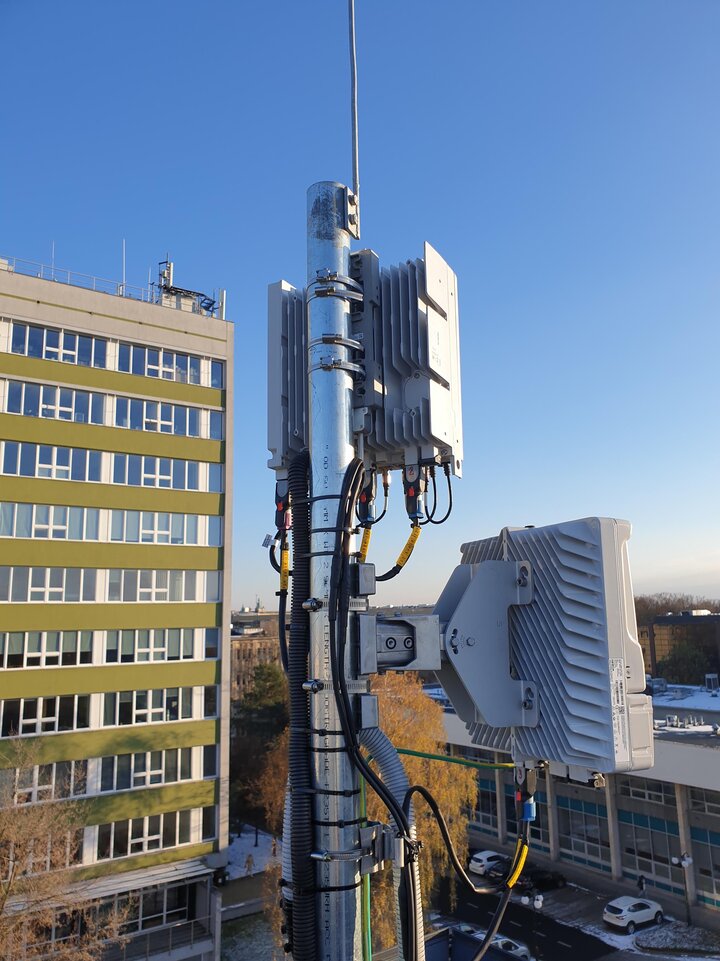The AGH University is one of very few in Poland to obtain a radio permit from the Office of Electronic Communications to use a private 5G network.
The launch of the 5G network is a result of a finished project “National Laboratory for Advanced 5G Research: PL-5G” implemented by a consortium consisting of the AGH University, the Warsaw University of Technology (leader of the project), the Institute of Telecommunications – National Research Institute, the Wrocław University of Science, and Technology, Gdańsk Tech, and the Poznan Supercomputing and Networking Center affiliated to the Institute of Bioorganic Chemistry of the Polish Academy of Sciences.
The overarching goal of the project was to create research infrastructure unique on the Polish scale for conducting practical research on 5G technologies and services.
As emphasised by Professor Jerzy Lis, the AGH University Rector:
“The significance of this project for the dynamic development of technology is enormous. In the near future we may anticipate common implementations of 5G solutions in national operator networks, which will result in a significant development of modern but also previously inaccessible services. Private 5G networks, which will be created by companies and local governments in the coming years, are also expected to grow rapidly. Thus, the 5G network at our university will allow us to carry out a number of tests, studies, and analyses that are relevant from both the operator's and the end user's point of view – such as data transmission delay, speed of transmitted information, possibility of using artificial intelligence algorithms, and connectivity between devices, all in advance."
Under the project, which had a total budget of nearly PLN 225 million (the AGH University had a budget of about PLN 25 million), the university created four laboratories located in the Institute of Telecommunications (Faculty of Computer Science, Electronics, and Telecommunications):
- 5G network laboratory,
- Laboratory of 5G simulators and measurement tools,
- 5G environment laboratory as regards the IoT,
- 5G environment laboratory as regards multimedia research.
As explained by Professor Marek Natkaniec of the Institute of Telecommunications, who coordinated the construction of the laboratories and the implementation of 5G networks at the AGH University:
“Each of our four laboratories is adapted to provide a range of services related to 5G networks. We purchased more than 1,000 devices related to 5G technology, which allowed us to prepare dozens of different laboratory stations. The list of proposed services seems to be endless. Thus, we will be able to conduct world-class research taking advantage of the access to a fully functional 5G backbone and access network, programmable radio equipment, a data storage and processing centre, a 5G network created based on components from various OpenRAN-type manufacturers, various 5G client terminals, and traffic generators. With the deployment of such extensive test stands, we are also able to provide commercial services related to the access to professional diagnostic equipment, radio and virtual space signal attenuation chambers, as well as equipment that allows us to perform objective, quality, and performance measurements of 5G networks.”


 Pre-election meeting with a candidate for the position of rector
Pre-election meeting with a candidate for the position of rector  Agreement on cooperation with OPAL-RT
Agreement on cooperation with OPAL-RT  Krakow DIANA Accelerator consortium members with an agreement
Krakow DIANA Accelerator consortium members with an agreement  Meeting with the Consul General of Germany
Meeting with the Consul General of Germany  More Academic Sports Championships finals with medals for our students
More Academic Sports Championships finals with medals for our students  Professor Jerzy Lis re-elected as AGH University Rector
Professor Jerzy Lis re-elected as AGH University Rector  Launch of AGH University Student Construction Centre
Launch of AGH University Student Construction Centre  Bronze for our swimmers at Academic Championships
Bronze for our swimmers at Academic Championships